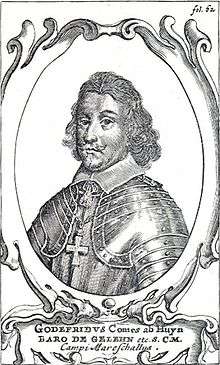Gottfried Huyn von Geleen

Gottfried, Count Huyn, Baron of Gleen or Godefridus Comes ab Huyn Baro de Geleen (died 27 August 1657),[1] rose to the rank of Field Marshal in the service of the Holy Roman Emperor during the 30 Years War.[2]
Biography
Gottfried was born in Flanders. In 1615 he joined the Imperial Army of the Holy Roman Empire in Italy as a volunteer. In 1618 he joined the Anholt Regiment of the Bavarian Army and remained with the regiment rising to the rank of colonel. While serving in the regiment he participated in the Count of Tilly's campaigns in Bohemia and the Rhine, then took part in the Siege of Magdeburg and at the Battle of Leipzig.[3]
After the Baron of Gleen had distinguished himself in 1632 by the defence of Wolfenbüttel against the Duke of Lüneburg, in June 1633 he received an independent command in Westphalia. With luck and skill, his 10,000 Catholic League troops scattered the armies of the Landgrave of Hesse and the Duke of Lüneburg, and against the Swedes under Torsten Stalhandske.[3]
Gleen joined the imperial service with the rank of generalwachtmeister (major-general). He fought in with the Imperial and Bavarian armies under Count of Hatzfeld and Count of Götz against Sweden and helped in the campaign that drove the Swedes under the command of Johan Banér back to the Baltic.[3]
In 1639, after unification with the Bavarians under Franz von Mercy, the Emperor transferred the command on the Rhine to Gleen. He crossed the Rhine near Speyer in October that year, but soon had to recross in order to drive the enemy from the Rheingau. In September 1640, after he had besieged and occupied Bingen, he combined is force of 4,000 infantry and 2,000 cavalry with the imperial army under Leopold Wilhelm at Fritzlar, but detached his force from the main army, to besiege Friedberg, and then wintered in bishoprics of Würzburg and Bamberg for an intended invasion of Sweden the following year.[3]
In early 1641, he helped to drive Banér from the Upper Palatinate and then marched to the Rhine in April, where he spent the next year in Cologne under Hatzfeld on an indecisive campaign against Guébriant. Soon after leaving the army, Gleen was retied as Province Commander (Landcomthur) of the Teutonic Order in the Bailiwick of Alden Biesen. But in 1644 he was called out of retirement by the Emperor on the advice of the Westphalian Circle.[3]
Gleen and his troops joined Mercy at Aschaffenburg, and advanced with the arm to Swabia. There Gleen commanded the right wing at the disastrous battle of Allerheim (Second Battle of Nördlingen). Mercy was killed and Gleen was captured, but after a short captivity Gleen was exchanged for the French General Grammont and then took command of the Beverian army.[3]
In 1646, Gleen, under the command of Leopold Wilhelm, took part in the campaign against Turenne and Wrangel, and in March of the following year, after the elector of Bavaria concluded ceasefire, he was asked to resign. He died in 1657 at Maastricht or Altenbiesen, with the death of his nephew, his titles became extinct.[3]
Notes
- ↑ Gottfried Graf Huyn, Freiherr von Geleen (Regarding personal names: Until 1919, Graf was a title, translated as Count, not a first or middle name. The female form is Gräfin. In Germany since 1919, it forms part of family names.. Regarding personal names: Freiherr is a former title (translated as Baron), which is now legally a part of the last name. The feminine forms are Freifrau and Freiin.)
- ↑ Stèphani 1877, p. 277.
- 1 2 3 4 5 6 7 Landmann 1878, p. 534.
References
- Stèphani, Jean Pierre R. (1877), Mémoires pour servir à l'histoire monastique du pays de Liége, publ. par J. Alexandre. 2 tom ... (in French), p. 277
- Attribution
 This article incorporates text from a work in the public domain: Carl von Landmann (1878), "Geleen und Amsterad, Gottfried Huyn Graf von", Allgemeine Deutsche Biographie (ADB) (in German), 8, Leipzig: Duncker & Humblot, p. 534
This article incorporates text from a work in the public domain: Carl von Landmann (1878), "Geleen und Amsterad, Gottfried Huyn Graf von", Allgemeine Deutsche Biographie (ADB) (in German), 8, Leipzig: Duncker & Humblot, p. 534
External links
| Wikimedia Commons has media related to Godfried Huyn van Geleen. |